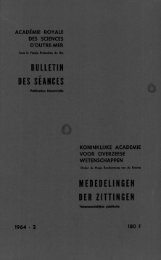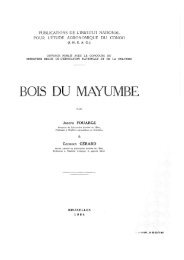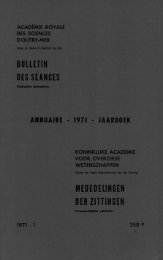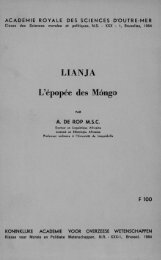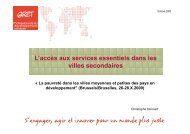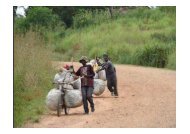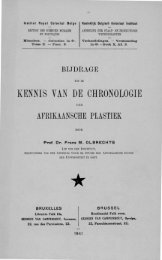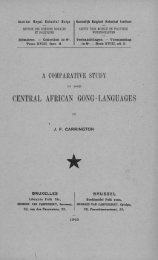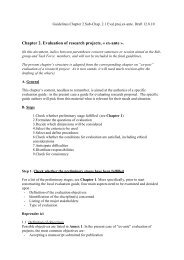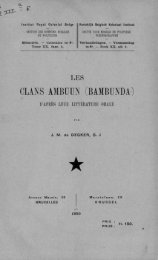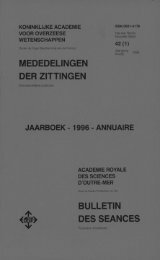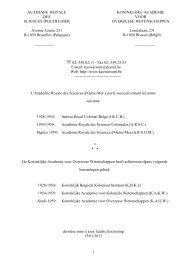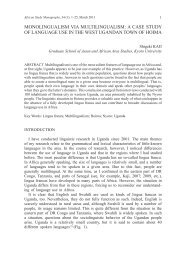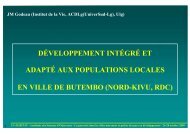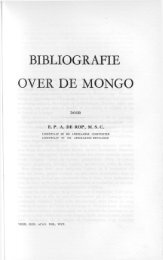(1986) n°2 - Royal Academy for Overseas Sciences
(1986) n°2 - Royal Academy for Overseas Sciences
(1986) n°2 - Royal Academy for Overseas Sciences
Create successful ePaper yourself
Turn your PDF publications into a flip-book with our unique Google optimized e-Paper software.
- 170 —<br />
a été analysée la concentration en sélénium du lait maternel en provenance de deux groupes<br />
différents de femmes allaitantes du Burundi. Chez le premier groupe de 21 femmes, toutes<br />
appartenant à un niveau social moyen de Bujumbura, capitale du pays, la période d ’allaitement<br />
varie entre 1 jour et 15 mois après l’accouchement. Cette même période varie entre 4 mois<br />
et demi et 22 mois chez le deuxième groupe de 20 femmes à très bas niveau social habitant<br />
à Ijenda, en plein milieu rural. La concentration en sélénium du lait maternel de chaque femme<br />
est présentée pour autant que possible en fonction de la période d’allaitement (colostrum, lait<br />
de transition ou lait définitif). En plus, l'ingestion quotidienne de sélénium en provenance du<br />
lait maternel définitif a été estimée pour les deux groupes d’enfants.<br />
S u m m a r y. — Preliminary results of a study on the selenium content in breastmilk in Burundi.<br />
— There is still a growing interest in the role of several trace elements <strong>for</strong> human health. From<br />
1979 selenium has been reported to be an essential nutrient <strong>for</strong> humans since it occurs mainly<br />
as an integral component of the enzyme glutathione peroxidase. For most industrialized<br />
countries data are available on the selenium content of food and on the daily dietary selenium<br />
intake. The intake depends on the type of food and the food consumption habits. For rural<br />
populations living in a system of subsistence economy a relationship has been established<br />
between their selenium intake and the presence of selenium in soils. In the present study<br />
breastmilk samples of two groups of lactating women were obtained and their selenium<br />
content analyzed. The first group consisted of 21 women belonging to the social middle class<br />
of Bujumbura, capital of Burundi, with lactation stages ranging from 1 day to 15 months post<br />
partum. The second group consisted of 20 women living in a poor rural area (Ijenda), with<br />
lactation stages ranging from 4.5 to 22 months post partum. For both groups the selenium<br />
content of individual breastmilk samples is given according to the lactation period (colostrum,<br />
transitional and mature milk). The average daily selenium intake <strong>for</strong> both groups of infants is<br />
estimated using the mean selenium content of the respective mature breastmilk.<br />
*<br />
* *<br />
1. Inleiding<br />
De explosieve ontwikkeling van de instrumentele analytische technieken, die<br />
toelaten om met een grote gevoeligheid én nauwkeurigheid elementanalysen uit te<br />
voeren, gekombineerd met een steeds beter inzicht in de rol van spoorelementen<br />
voor de menselijke gezondheid, zijn de oorzaken van een steeds meer toenemende<br />
belangstelling vanwege de verschillende biomedische disciplines voor de spoorelementen<br />
(Comité d’experts de l’OMS, 1973).<br />
Een typisch voorbeeld is seleen, dat aanvankelijk - tot in het begin van de jaren<br />
vijftig — uitsluitend beschouwd werd als een spoorelement met alleen toxische, zelfs<br />
cancerogene, eigenschappen. In 1957 werd echter bij proefdieren aangetoond dat<br />
seleen een essentiële fiinktie vervult. Talrijke deficiëntieziekten bij het vee, waarvan<br />
de symptomen reeds vroeger beschreven waren, o.a. de zgn. «white muscle disease»,<br />
gekenmerkt door een verzwakking van hart- en skeletspieren, konden voorkomen<br />
worden door toediening van seleenverbindingen. Sedert de ontdekking in 1972, dat<br />
seleen een integrerend deel uitmaakt van het belangrijke enzyme, het glutathionper-



